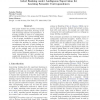Free Online Productivity Tools
i2Speak
i2Symbol
i2OCR
iTex2Img
iWeb2Print
iWeb2Shot
i2Type
iPdf2Split
iPdf2Merge
i2Bopomofo
i2Arabic
i2Style
i2Image
i2PDF
iLatex2Rtf
Sci2ools
ICML
2010
IEEE
2010
IEEE
Label Ranking under Ambiguous Supervision for Learning Semantic Correspondences
This paper studies the problem of learning from ambiguous supervision, focusing on the task of learning semantic correspondences. A learning problem is said to be ambiguously supervised when, for a given training input, a set of output candidates is provided with no prior of which one is correct. We propose to tackle this problem by solving a related unambiguous task with a label ranking approach and show how and why this performs well on the original task, via the method of task-transfer. We apply it to learning to match natural language sentences to a structured representation of their meaning and empirically demonstrate that this competes with the state-of-the-art on two benchmarks.
| Added | 09 Nov 2010 |
| Updated | 09 Nov 2010 |
| Type | Conference |
| Year | 2010 |
| Where | ICML |
| Authors | Antoine Bordes, Nicolas Usunier, Jason Weston |
Comments (0)

